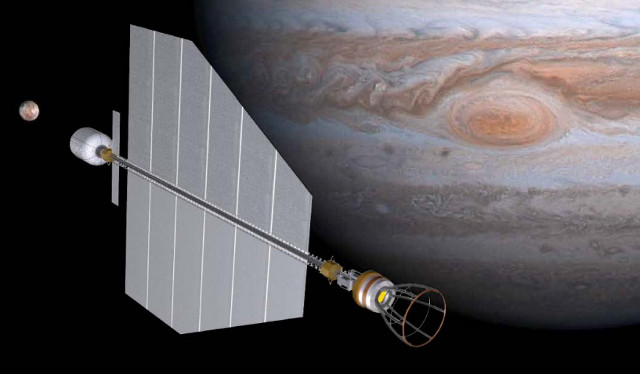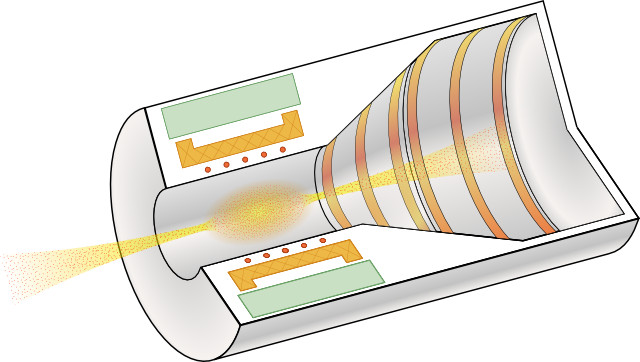Travelling to very distant objects in space such as stars and exoplanets will require very large amounts of thrust to drive rockets to very high speeds in order that we can travel there in a reasonable amount of time. Conventional chemical rockets are unsuitable for this purpose as the thrust they provide is limited by the amount of fuel that they can carry. So far we have only travelled as far as the Moon, and that’s a mere 380 000 kilometres away.

An artist’s impression of a possible FFR design. The large grey fins are for cooling and the crew habitat or payload area is at the far end, pointing away.
The fission fragment rocket (FFR) is a theoretical engine design that uses the products of nuclear fission (“fission fragments“) to generate thrust. These fission fragments cannot normally escape from the fuel, but in an FFR this is designed to be not only possible but likely. A number of different designs have been proposed, but perhaps the most promising is the “Dusty Plasma Rocket” proposed* by Rodney Clark and Robert Sheldon.
In Clark and Sheldon’s dusty plasma rocket the fuel is a magnetically- and electrostatically-confined plasma containing tiny grains of radioactive fuel, each no more than one hundred nanometres in diameter. As the fuel fissions, the fission fragments are steered either to collection electrodes to generate electrical power, or out the back of the engine to generate thrust.

A schematic of Clark and Sheldon’s dusty plasma rocket. Fission fragments are ejected to the left to produce thrust, and on the right are collected by electrodes for electrical power. Also shown are the RF coils (red dots) used to heat the plasma and the containment field generator (orange) required to keep the dust cloud in place. The beryllium oxide or lithium hydride moderator is shown in light green.
Although the mass of the fission fragments is very small, they exit at speeds of a few percent the speed of light and are therefore able to generate a significant thrust force. An FFR “burning” one hundredth of one gram of fuel per second and ejecting those fragments at five percent of the speed of light would still be able to generate a force of 150 newtons and Clark and Sheldon calculate that their dusty plasma rocket would be able to generate a specific impulse (ISP) of 1.5 million seconds. Specific impulse is a measure of the efficiency of a rocket engine and compares the force generated with the mass of propellant used per unit time, and for comparison purposes each of the Space Shuttle Main Engines had an ISP of between 360 and 450 seconds (as ISP varies with altitude). An FFR therefore offers a huge improvement in efficiency over standard chemical rockets.
Perhaps the most interesting aspect of the fission fragment rocket is that unlike other proposed long-distance rocket designs such as matter-antimatter reactors, it is well within current technological capabilities: we could begin building an FFR tomorrow. Clark and Sheldon calculate that a ten-year mission to the Sun’s gravitational lens point, 550 astronomical units (82.2 trillion metres) from Earth would require only 180 kg of nuclear fuel and a 350 megawatt reactor, both of which are well within current design parameters.
* Rodney Clark and Robert Sheldon, “Dusty Plasma Based Fission Fragment Nuclear Reactor”, 41st AIAA/ASME/SAE/ASEE Joint Propulsion Conference & Exhibit (2005). PDF Link.
Do you think an engine like this will be able to be launched from Earth, given that it sounds like it will leave behind a huge mess (is it messy?), or will it have to be built and launched from space?
With nothing to stop them the fission fragments will travel away from Earth. Providing you don’t point the engine towards Earth I think you’d be okay. Clark and Sheldon address the issue of radiation hazards in §IV.A of their paper and state that “Because the Fission fragments are highly charged, they are trapped by the magnetic field of the Earth until the rocket is outside the Earth’s magnetosphere, or about 10 Earth radii” and that “The short halflife isotopes generally decay into stable isotopes before entering the troposphere, whereas the very long halflife isotopes pose no threat of radioactivity”. They explain that “the amounts [of radioactive isotopes] reaching the Earth should be compared to the 300 curies of carbon-14 produced every year by cosmic rays” and that in a worst-case scenario using a very large fuel burn (30 years, 0.5 light-year distance) only 3600 Ci of (for example) caesium-137 would reach Earth (and this radiation would be spread over a very large area).
would the particles be trapped within the solar system and pose an eventual threat to future travelers the way obsolete satelites do in earth orbit (they were no problem at the beginning)
The amount of radioactive particles present would be extremely small, as the FFR burns fuel at a *very* slow rate (which is one of the things that makes it suitable for long-distance long-term travel) of the order of fractions of a gram per second. This means that the risk is very low. If the particles were trapped by the magnetosphere in orbit around Earth I imagine you’d be moving through them quite quickly, so that’s another possible reason to think of the FFR as low risk.
What are the fuel consumption rates for these sorts of rockets? In other words, is there some way to predetermine how much fuel mass would need to be used? (of course, if you already know the payload mass)
The post lists 0.5 grams per second as a reasonable rate of fuel consumption.
Could the rocket use Thorium Hydride? Thus saving the weight of the moderator. Started by firing a proton beam at the dust, causing fission as well as the release of fast protons, some of which reflect from the magnetic mirror to sustain the reaction.
Or perhap the addition of Lead to increase the slow Neutron flux, to cause Thorium fission?